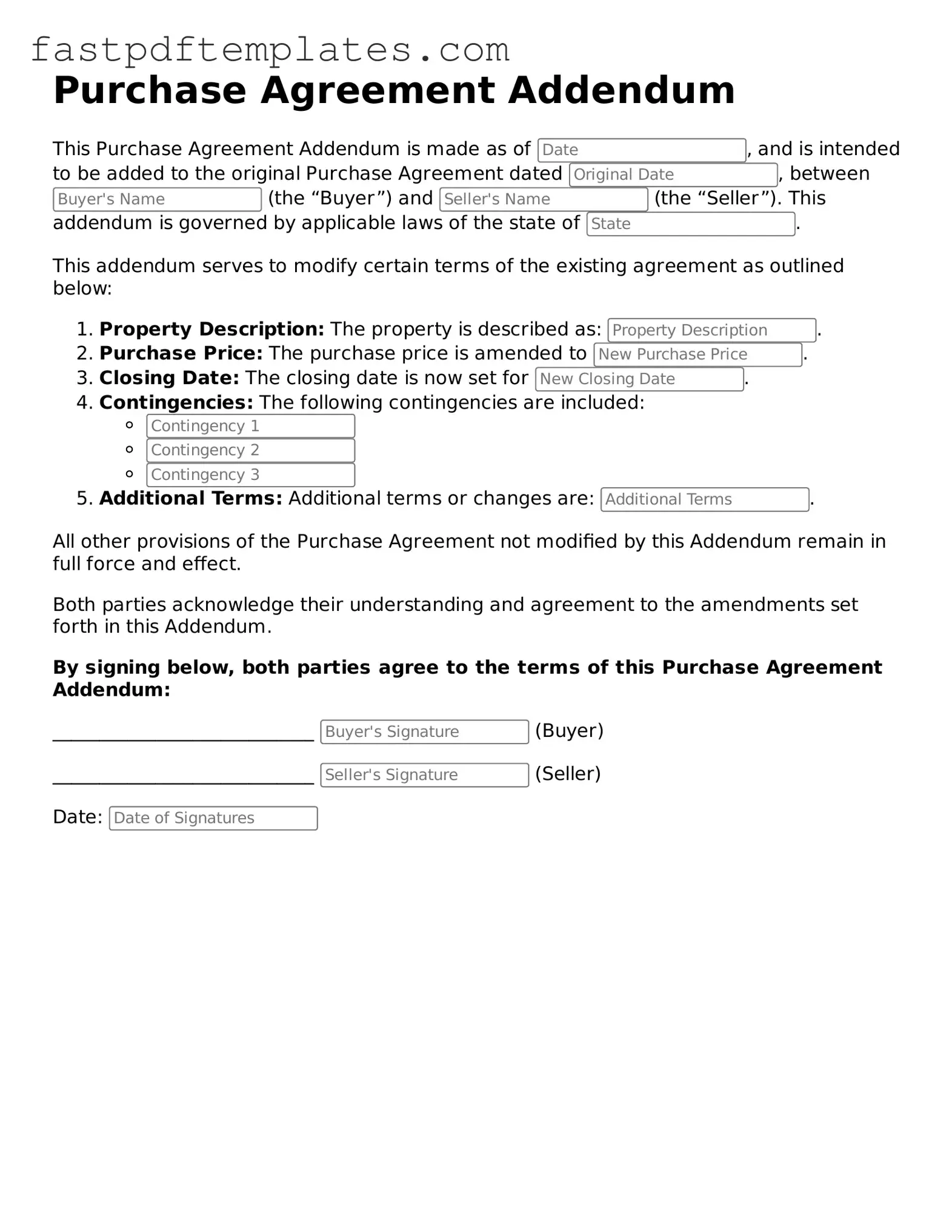The Purchase Agreement Addendum form is closely related to the Amendment to Purchase Agreement. This document serves a similar purpose by modifying the original purchase agreement. When parties wish to change specific terms, such as the purchase price or closing date, they can use this amendment. It outlines the agreed-upon changes while ensuring that the original agreement remains intact, providing clarity and legal protection for both parties.
Another document that resembles the Purchase Agreement Addendum is the Letter of Intent. This document outlines the preliminary understanding between the buyer and seller before finalizing the purchase agreement. While it is not legally binding, it sets the stage for negotiations and can include essential terms that will later be incorporated into the formal agreement. Both documents aim to establish clear expectations and facilitate a smoother transaction process.
The Counteroffer form is also similar to the Purchase Agreement Addendum. When a buyer or seller disagrees with the terms of the initial agreement, they can issue a counteroffer, proposing new terms. This document acts as a negotiation tool and can lead to a modified agreement, much like an addendum. Both serve to clarify the intentions of the parties involved and help reach a mutually acceptable deal.
The Disclosure Statement shares similarities with the Purchase Agreement Addendum in that it provides important information regarding the property being sold. While an addendum modifies the agreement, a disclosure statement informs the buyer about potential issues or defects related to the property. This transparency is crucial for making informed decisions and can influence the terms of the purchase agreement.
The Termination Agreement is another document that can be compared to the Purchase Agreement Addendum. When parties decide to end their negotiations or cancel the purchase agreement altogether, a termination agreement outlines the terms of that decision. While an addendum modifies existing terms, a termination agreement effectively nullifies the agreement, providing a clear path forward for both parties.
The Bill of Sale is also akin to the Purchase Agreement Addendum, albeit at a different stage of the transaction. Once the purchase agreement is finalized, a bill of sale serves as proof of the transfer of ownership. It documents the sale and can include details about the items sold, similar to how an addendum clarifies specific terms within the agreement. Both documents are essential for ensuring that the transaction is legally recognized.
The Closing Statement bears resemblance to the Purchase Agreement Addendum in that it summarizes the final details of the transaction. This document outlines the financial aspects, including the purchase price, closing costs, and any adjustments made. While the addendum modifies terms before closing, the closing statement confirms those terms and provides a comprehensive overview of the transaction's finalization.
The Escrow Agreement is another document that can be related to the Purchase Agreement Addendum. This agreement outlines the terms under which a neutral third party holds funds or documents during the transaction. While an addendum modifies the purchase agreement, an escrow agreement ensures that both parties fulfill their obligations before the transaction is completed. Both documents work together to protect the interests of the buyer and seller.
The Warranty Deed is also similar to the Purchase Agreement Addendum in that it is used during the transfer of property ownership. This document guarantees that the seller has the right to sell the property and provides assurances to the buyer regarding the title. While an addendum modifies terms within the purchase agreement, a warranty deed formalizes the transfer of ownership, ensuring both parties understand their rights and responsibilities.
Lastly, the Lease Agreement can be compared to the Purchase Agreement Addendum, particularly when the property is being sold with tenants in place. This document outlines the terms under which a tenant can occupy the property. While the addendum modifies the purchase agreement, the lease agreement addresses the ongoing rights of tenants, ensuring that both the buyer and seller are aware of the implications of the sale on existing rental agreements.
